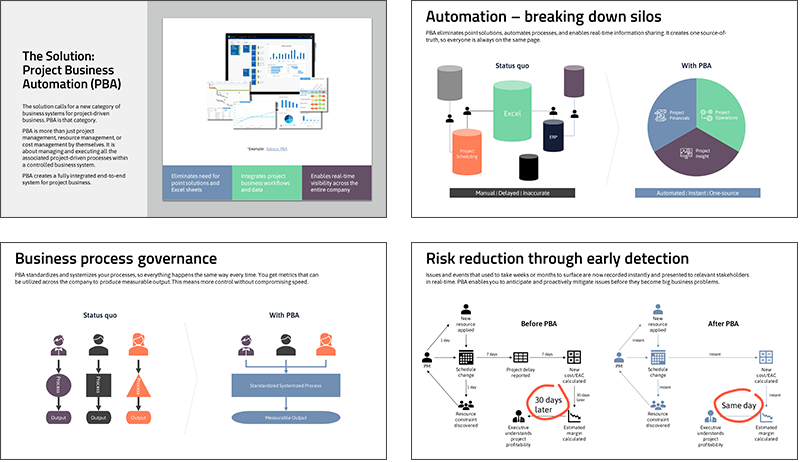When buying and implementing a business system, you want to ensure that the value received from the system is many times the cost of it, otherwise, why would you buy it? When it comes to Project Automation , what is the value it brings to your company?
Many people can see the immediate efficiencies that Project Automation can bring to their company. For example, it eliminates the need for multiple tools and spreadsheets to manage your projects. However, what does Project Automation really mean to the bottom line? How can you identify and quantify the value of Project Automation for the business?
When it comes to driving business value, Project Automation emerges as a comprehensive solution that encompasses various dimensions of your organization. By identifying and quantifying the benefits, you can unlock the true potential of Project Automation in five key areas. Let’s delve deeper into these areas, how Project Automation is improving them, and explore the impact on your business.
IT Consolidation
Project Automation serves as a holistic business system, integrating core project functionalities that are typically spread across multiple point solutions. This consolidation enables you to eliminate or reduce the need for various standalone applications such as project management, resource management, project estimation, billing, time and expense tracking, and business intelligence tools.
The direct impact?
Substantial cost savings through the elimination of redundant applications, associated licensing fees, and support expenses.
Case Study: Rex Moore Eliminates 15 Systems with Project Automation
Project Admin Savings
With Project Automation, the days of manually gathering, importing/exporting, and manipulating data between systems are gone. This eliminates the need to reconcile data and generate project metrics and reports across disparate systems. Project Automation can eliminate the reliance on cumbersome spreadsheets and free up valuable time that can be invested in driving strategic initiatives.
Case Study: Administrative Savings with Project Automation
Industry: Oil & Gas engineering and construction
Employees: 350
Result: redeployed 5.5 full-time cost accountants + significant time savings among all project employees
The result?
A significant reduction in administrative tasks and hours spent on data manipulation. By recapturing these hours, your workforce can redirect their efforts toward more productive areas, propelling your business forward.
Project Throughput
PlanAutomate excels at increasing project throughput, giving your organization the capacity to take on more projects. By seamlessly integrating project data and automating critical processes, Project Automation empowers your team to accomplish more with fewer resources. Your team spends less time searching for problems and more time solving them, leading to increased productivity. Project Automation’s extensive feature set, integrated with your ERP, provides a comprehensive solution.
From accurate project modeling and sophisticated budget management to advanced scheduling and resource allocation, Project Automation streamlines project operations. It also offers real-time monitoring, various workspaces based on role, automated reporting, and more.
The result?
Improved revenue and increased margins as your team becomes more efficient, delivering projects on time and within budget.
Resource Utilization
Project Automation seamlessly integrates advanced resource management into your ERP, providing better visibility and optimization of revenue-generating resources across your organization. Real-time insights into company-wide resource capacity and utilization enable effective resource allocation and accurate demand forecasting. Project Automation’s automated task workflow engine ensures projects stay on track, while features like assignment notifications, progress tracking, and conflict detection streamline resource management.
The result?
Increased resource utilization, which translates into increased revenue that directly adds to your bottom line.
Risk Management
Project Automation significantly improves risk management through its powerful features. By keeping your team updated in real-time about critical areas of your projects, Project Automation mitigates the risks of schedule delays and cost overruns.
Relevant Project Automation Features:
- With Project Automation’s project modeling capabilities, you can reduce rework through accurate estimation and planning.
- The RAIDO framework enables you to log and track risks, assumptions, issues, dependencies, and opportunities, forecasting their financial impact and ensuring timely resolution.
- Project Automation’s Project Autopilot functionality automatically notifies stakeholders of deviations in critical project metrics, enabling proactive management.
- Sensor Points provide early detection of issues before they escalate, and EVA metrics ensure project performance.
The impact?
Manage your project risks better for reduced budget overruns and significant cost savings.
Project Automation Value Conclusion
In conclusion, Project Automation delivers comprehensive business value across your organization. Through IT consolidation, administrative savings, increased project throughput, improved resource utilization, and enhanced risk management, Project Automation transforms the way you operate. It eliminates redundancy, improves efficiency, boosts revenue, and reduces costs.
As a result, our customers target a 2 to 5% improvement in the bottom line through the use of Project Automation. This value ensures that you achieve a healthy return on your investment.
By harnessing the power of Project Automation, your business gains a competitive edge, ensuring successful project delivery and sustainable growth.
Download the Project Automation Quick Guide to learn more about how Project Automation works to add value to your organization.


